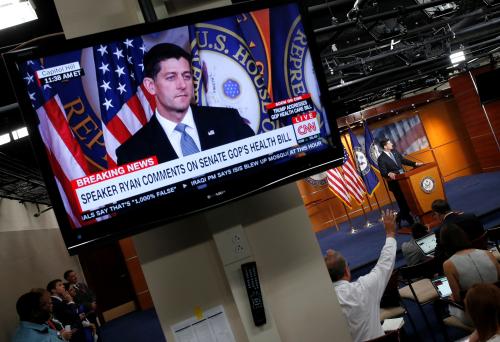The following brief is part of Brookings Big Ideas for America–an institution-wide initiative in which Brookings scholars have identified the biggest issues facing the country and provide ideas for how to address them.
Health policy has become a highly charged partisan issue in American politics. Each party claims that its policies will improve the quality, efficiency, and availability of American health care, while the other party’s policies will destroy what is good about it. Realistically, however, any major sustainable changes in federal health policy will require broad public support and bipartisan agreement in Congress, even when one party controls both the White House and the legislative branch of government.
In a less polarized political atmosphere, the 2016 campaign could have allowed candidates to articulate realistic positions, help voters understand the options, and provide a basis for legislation when the new president and Congress take office in 2017. Unfortunately, the 2016 campaign has mainly featured slogans such as “Repeal Obamacare!” and “Save Medicare!” and mutual accusations of nefarious intentions that only deepen the partisan divide and raise barriers to constructive action in 2017 and beyond. The new president and Congress face at least three big health policy issues:
- Resolving the future of the Affordable Care Act (ACA);
- Slowing projected growth of national health spending on the federal, state, and private levels; and
- Reforming the Medicare program in a way that extends the life of the Medicare HI Trust Fund and moderates the growth of the Supplementary Medical Insurance trust fund to ensure the program’s viability for ever more beneficiaries.
The American health care delivery and payment systems are extraordinarily complex. Proposed policy changes involve controversial tradeoffs and are hard to make clear to most voters. The three issues are also highly interrelated. For example, the ACA increased federal spending for health by creating subsidies for the purchase of health insurance and expanding Medicaid. At the same time, it reduced spending for Medicare and introduced reforms likely to make health care delivery more efficient. Hence, repealing the ACA in its entirety would make Medicare reform and spending concerns harder to resolve.
Partisan Ideology and Political Reality
Traditionally, the Republican and Democratic parties have had different approaches to health care, especially in campaigns, even though members of both parties have diverse views on health policy. Republicans emphasize market solutions, consumer choice, reduced waste and regulation, and more state-level flexibility in designing and executing health programs. They argue for tort reform to reduce malpractice premiums, health savings accounts to give consumers more control over health spending, and interstate health insurance markets to enhance competition. Democrats emphasize universal health insurance coverage, support enlarging the government’s role in ensuring access to health care, and tend to favor health sector regulation to improve quality and moderate cost growth. They emphasize the millions of elderly and vulnerable people benefiting from Medicare and Medicaid and the ACA extension of health insurance coverage, and push for further expansions in coverage and benefits under federal programs.
As President-elect Trump and Congress begin to tackle these challenges, however, they will find their options severely limited. The American public generally is apprehensive about change in anything as vital and personal as health care. Reducing benefits for people who have federally supported coverage is politically hazardous. Medicare is popular, and modifications to it must be designed to assuage the fear of current beneficiaries and their families that they might end up worse off. Moreover, the health care establishment—providers, insurers, suppliers—forms a large, politically sophisticated economic sector (close to 18 percent of U.S. GDP) whose powerful lobbies protect the system’s existing jobs and incomes. Newly elected policymakers proposing major health policy changes will face a daunting battle with entrenched stakeholders determined to defend and enhance their interests.
The Future of the Affordable Care Act
The clearest policy divide between the presidential candidates was over the future of the ACA. Although the ACA broadened health insurance coverage in market-oriented ways that might have held appeal for Republicans, such as subsidies for the individual purchase of competing private insurance plans chosen on electronic exchanges, the act was passed by Democrats without any Republican support. Republican congressional leadership, hoping to discredit President Obama, opposed it from the beginning. In the 2016 campaign, Republican candidates demonized “Obamacare” as the federal government forcing people to buy health insurance even if they did not want it, punishing small business with mandatory costs, and raising premiums for everyone.
The clearest policy divide between the presidential candidates was over the future of the ACA.
In the 2016 primaries, all Republican candidates trashed Obamacare and promised to “repeal and replace” the ACA, thereby aiming to fulfill the unsuccessful four-year effort of congressional Republicans and deliver on a major plank in the party’s platform. Several Republican primary candidates offered ideas for replacing the ACA, suggesting tax credits for the purchase of health insurance and either retaining the ACA insurance market reforms or replacing them with federally supported state-based high-risk pools or other devices. Donald Trump, however, said only that he would replace ACA with “something great.” His campaign materials stated his belief that “every American deserves access to high-quality, affordable health care,” but provided few relevant policy details about how that could be achieved. He said he favored enabling those without employer-sponsored insurance to deduct their premiums from taxable income, allowing health insurance to be sold across state lines, expanding importation of prescription drugs, having Medicare negotiate drug prices with pharmaceutical manufacturers, and transforming Medicaid into block grants for states. He has since said that he favors retaining two popular insurance market reforms: prohibiting denial of affordable coverage to those with preexisting conditions and allowing young people to stay on their parents’ health insurance until age 26.
In the Democratic primary campaign, Bernie Sanders argued forcefully for a single-payer system (Medicare for All), a proposal long popular with the progressive wing of the Democratic Party, and acknowledged that paying for such a program would require substantially higher federal taxes. Hillary Clinton celebrated the accomplishments of the ACA in drastically cutting the proportion of Americans without health insurance, argued for enhancing the incentives to states to expand Medicaid, and proposed policies that would make ACA insurance more accessible and affordable. As Democratic nominee, Clinton moved in the Sanders campaign’s direction by suggesting that people over age 55 be allowed to buy into Medicare before they reach the current eligibility age of 65, and that a public option be available on the ACA exchanges in all states to compete with private plans.
Having won the White House and retained control of both chambers of Congress, Republicans are in a position to repeal Obamacare early in 2017. They could use the reconciliation process in a budget resolution to repeal the spending and tax provisions of the ACA, thereby circumventing the 60-vote hurdle needed to close down a Senate-level Democratic filibuster. The consequences of defunding the ACA without enacting replacement legislation, however, would be chaotic even if the repeal were stipulated to be effective one or two years in the future. Some 20 million people who currently benefit from ACA coverage would not know how comprehensive or affordable their future coverage might be or even whether a replacement plan would even be enacted. Insurers, uncertain about possible changes in the risk pool and with only a short period of time to recoup any investments they may need to make, could decide to stop offering coverage through the exchanges. Providers could be less willing to participate in the dwindling number of exchange plans. Compliance with the individual mandate, particularly among the healthy, would probably crumble. And the impetus behind many of the efforts to curb cost growth, which the ACA has spawned, could dissipate.
Replacement legislation will require bipartisan backing to be permanently viable, and it will take time to craft.
Replacement legislation will require bipartisan backing to be permanently viable, and it will take time to craft. A full year might be required. None of the existing replacement plans have specified the detail required to address the tradeoffs and stakeholder concerns that an implementable plan requires. Without such detail, it is impossible to know with any certainty how many people will be covered, how affordable that coverage will be, what costs the government will face, and what will happen to the quality of care. Beyond the legislation, the associated regulations will have to be drafted, commented upon, and revised before any replacement structure can be implemented, which could require another year of work.
One optimistic scenario is that the Trump administration and congressional Republicans will realize the enormity of the replacement challenge and work with congressional Democrats and key health stakeholders to craft workable replacement legislation. The new law could keep the ACA’s popular insurance market reforms, preserve the current rate of insurance coverage, and make buying health insurance more attractive to younger, healthier people and selling individual insurance more financially rewarding to insurance carriers—a tall order for such legislation.
The ACA transformed health insurance markets so the carriers could no longer compete primarily by attracting healthy, less expensive customers with lower premiums while excluding or charging higher rates to the less healthy. Only age (within narrow limits) and smoking behavior were subject to consideration. The hope was that the combination of income-related subsidies and penalties for not buying insurance (the individual mandate) or for not offering it to employees (the employer mandate) would result in rapid expansion of insurance coverage. Medicaid expansion was counted on to cover the poor and near-poor.
Roughly 20 million more people now have coverage (about half on the exchanges and half through Medicaid expansion) and the proportion of people without coverage has declined. But stresses in the insurance market revealed problems in the ACA’s design. Not surprisingly, the sickest people signed up. The complex mechanisms the ACA established to compensate insurers that attracted particularly costly participants proved inadequate. Healthier people, particularly the young, often faced higher premiums for individual insurance options because their insurance did not meet the ACA’s higher benefit standards. The subsidies and penalties were insufficient to induce many of the “young invincibles” to sign up. Insurance carriers found that the new population of previously uninsured customers was more expensive than they expected. Some underpriced their offerings, experienced losses, and began to raise premiums or withdraw from some markets, leaving beneficiaries with fewer choices. Some states also chose not to expand Medicaid, leaving a substantial group of people without affordable coverage.
An optimistic scenario assumes that Republicans are sufficiently dedicated to the goal of broadening access to affordable, good-quality care—with private insurance competition as the preferred model—that they will be willing to hammer out a replacement plan that fixes ACA shortcomings and transitions current beneficiaries to the new structure. It also assumes that some Democrats are willing to work with them and to accept more Republican-friendly attributes rather than opposing such proposals. Elements of such a structure might include allowing insurance companies more flexibility to offer cheaper plans with more limited benefits, bigger differences in premiums by age, greater reliance on health savings accounts, and some ways of combining insurance pools across state lines. Capping the tax exclusion of employer-paid health premiums (espoused by some Republicans, including 2012 presidential candidate John McCain) could be substituted for the yet-to-be-implemented “Cadillac tax” on high-cost employer-sponsored plans and some of the other revenue-increasing measures. Some of the Clinton proposals might also appeal to Republicans, including a refundable tax credit for those with high out-of-pocket expenses, limitations on out-of-network charges for care delivered in in-network hospitals, greater price transparency, and relaxation of restrictions on the importation of prescription drugs.
None of this would be easy. A Republican replacement plan would doubtless eliminate both the employer and the individual mandates. Some independent analysts have concluded that the employer mandate has only a marginal impact on coverage (but not on costs). However, some substitute would have to be found for the individual mandate that gave younger, healthy people more incentive to buy coverage and thereby reduce average costs. One option would be to follow Medicare’s example by imposing a premium surcharge that increased each month that an individual failed to obtain coverage.
Republicans will also want to give more flexibility to states, not only in Medicaid but also in using federal money to subsidize purchases of private health insurance. This state flexibility could appeal to some Democrats as well. Indeed, the ACA moved in this direction in its Section 1332 waivers: starting in 2017, states are able to substitute a state-designed structure for the ACA as long as the plan achieved the access, coverage, quality, and cost goals of the ACA. This idea could be expanded in the replacement. Much would depend on the attitude of Republican governors toward Medicaid expansion. Some took advantage of the ACA’s federal inducements to expand coverage. However, 19 conservative states did not expand Medicaid eligibility to 138 percent of the federal poverty level (FPL), which cost their states tens of millions of dollars and opened up a glaring inequity that developed after the Supreme Court decision made the state Medicaid expansion optional. The Obama administration has used Medicaid’s Section 1115 waiver authority to extend coverage in six states, but roughly 3 million are still uninsured because they fall into the coverage gap—those whose incomes are less than the 100 percent of poverty threshold for eligibility for subsidized coverage in the exchange, but above their state’s Medicaid eligibility level. Since the replacement for the ACA would no longer be associated with a Democratic administration, some Republican governors might be more willing to accept federal funds to fill this gap and broaden coverage in their states. Another approach would be to provide all states with the option of scaling back the Medicaid expansion threshold from 138 percent to 100 percent of the FPL while providing federally funded premium tax credits and cost-sharing subsidies to those with incomes between 100 and138 percent of the FPL who enroll in fully federally subsidized exchange plans. This would assuage concerns about future state responsibility for Medicaid costs and would reduce the numbers of families shifting back and forth between Medicaid and exchange coverage.[1]
Beyond these policies, there is a long list of lessons from the ACA experience that should be drawn on to inform any replacement effort. One is the necessary level of subsidies/tax credits to ensure participation in a system without individual mandates. Much as Republicans would like to reduce the costs of premium and cost-sharing subsidies, analysts have suggested that even the levels provided by the ACA were likely to prove inadequate, making exchange policies increasingly unaffordable for middle-income and elderly families.[2] Another is the importance of information technology, education, outreach, and regulation oversight and enforcement. Of even more importance is the need to take measures to expand and stabilize the insurance offerings whether offered through exchanges or some other marketplace. A number of large for-profit insurers have withdrawn from the exchange marketplaces altogether, while others have reduced the counties in which they are offering coverage. Only 6 of the original 23 Consumer Operated and Oriented (CO-OP) plans will be offering policies in 2017. In some areas, plan premiums have increased while deductibles and cost sharing in lower cost plans have soared. Among the explanations suggested for these trends are that marketplace enrollees are less healthy than expected, enrollment is much smaller overall than projected (especially in rural areas), enrollees purchase insurance only when they need expensive care and then stop paying their premiums after treatment, and the revenue redistribution mechanisms failed to operate as planned.
Health insurance carriers have found it difficult to make profits in sparsely populated rural areas with few customers and few providers. ACA exchanges frequently offered limited choices in such areas. Democrats have suggested creating a public option to ensure competition, but Republicans are unlikely to support such a plan and might prefer it if the federal government paid for, through competitive bids, a private plan that would offer insurance in counties with no or few exchange offerings. Until the marketplaces for subsidized insurance stabilize, insurers need to be more comfortable with the accuracy, predictability, and adequacy of the new risk adjustment system.
Moderating the Growth of National and Federal Health Care Spending
The United States devotes an extraordinary 18 percent of its GDP to health care—a substantially larger fraction than other advanced countries with modern health care systems. For several decades, health spending per capita grew faster than most other spending and seemed likely to push the fraction of economic resources devoted to health care ever higher—to 20 percent and beyond—squeezing competing needs in public and private budgets, including investments in young people. However, recently, health spending slowed markedly. Over the past five years (2010–15), National Health Expenditures (NHE) rose at an average of 3.5 percent a year on a per capita basis, compared with 6.0 percent in the previous decade (2000–10). From 2010 to 2015, Medicare spending rose by 1.4 percent per beneficiary; the comparable Medicaid figure was 1.7 percent.
The causes of the recent spending slowdown are the subject of a lively debate. The Great Recession, low overall inflation, the ACA’s cost-reduction measures and other federal initiatives, employer efforts to constrain spending by shifting costs onto workers through high-deductible and narrow network plans and other mechanisms, the shift to generic drugs, a slowdown in the introduction of expensive new interventions and blockbuster branded drugs, and provider efforts to improve efficiency have all played some role in slowing the growth in per capita costs.
Even without election-related disruption in the health sector, spending growth is expected to accelerate. Per capita NHE are projected to rise 4.9 percent per year over the next 10 years, Medicare spending at a rate of 4.3 percent per beneficiary, and Medicaid expenditures at a rate of 4.6 percent per enrollee. When looking at total, rather than per capita, health care spending, demographic trends will exacerbate the situation. Over the next decade, the baby boomers will expand Medicare’s rolls by almost 3 percent a year. While the under-65 population will be growing by 0.4 percent a year, an increasing fraction will be concentrated in the 50–64 age group, where average medical expenditures for the nonelderly population tend to be high.
The lull in new expensive medical innovations seems to be coming to an end. Pharmaceutical manufacturers are introducing expensive new drugs for cancer and other chronic conditions—often costing well over $50,000 per year—along with pricey innovations based on genomic and nanotechnology breakthroughs. In addition, provider consolidation (hospital, nursing home, and home health agency mergers), acquisitions of insurance companies by other insurers, and the purchase of physician groups by hospitals threaten to reduce what little effective competition exists in the health care sector.
Faced with the prospect of rapid health care spending growth, the new administration should lay out its view on the seriousness of the challenge and how it proposes to address it. It will have to make clear what the ACA substitute will do to replace the health spending reductions. The ACA contains initiatives such as the Cadillac tax, Medical Loss Ratio limits, and premium rate reviews that are intended to dampen expenditure growth by private plans. What measures would replace these?
The ACA also reduces the growth of Medicare’s spending significantly. It cut payments to most institutional providers and to Medicare Advantage plans, initiated multiple demonstrations and pilot programs to test various cost-reduction approaches, and established the Innovation Center within the Centers for Medicare and Medicaid Services to explore new payment methods for government programs and a nonprofit Patient-Centered Outcomes Research Institute to sponsor research on cost reductions and improved care delivery. It also called for creation of the Independent Payment Advisory Board, a body charged with instituting cost-reducing measures if Medicare’s spending exceeds specified target growth rates.[3] Many of these initiatives have yet to show significant impacts on the pace of cost growth; the Congressional Budget Office has estimated that Medicare’s direct spending would increase $802 billion over the 2016–25 period if the ACA were repealed.[4] Advocates of repeal will have to decide which, if any, of the ACA’s cost-saving measures they would retain and what alternative approaches they would propose.
Reforming Medicare to Extend the Life of the Trust Fund
Beyond the ACA, the Trump administration and Congress also face looming challenges in preserving Medicare solvency. The Trust Fund, out of which Medicare pays hospital claims, is projected to be depleted in 2028, even with all of the ACA’s Medicare savings. At that point, revenues dedicated to Medicare will cover only 87 percent of Medicare’s Hospital Insurance’s (HI) costs. Unlike other components of the federal budget except Social Security, Medicare has no legal authority to run a deficit in the Trust Fund and would have to cut spending. Repealing the ACA in its entirety would accelerate, possibly to the middle of the next decade, the date of Trust Fund depletion, as spending would increase when the productivity-related reductions in payment updates for institutional providers (such as hospitals and skilled nursing facilities) and other cost-reducing measures disappear, and when the increase in payroll taxes on those with high earnings required by the ACA is terminated, thereby reducing the Trust Fund’s revenue.[5]
Moderating the growth of spending of the physician and drug components of Medicare (Part B and Part D) is also important. Under current law, general revenues automatically cover any difference between spending in parts B and D and premiums collected, which increases the federal deficit. With total Part B and Part D spending projected to rise by an average of 7.3 percent and 9.7 percent a year respectively over the next decade, these programs will burden both federal budget resources and beneficiaries (who will face rising premiums tied to increased program costs). Over the next two decades, parts B and D expenditures are projected to grow by 0.67 percent of GDP.
The new administration and Congress should address the future of Medicare and not wait until HI trust fund depletion forces hasty action. Doing so will permit a wider range of solutions to be considered, solutions that can distribute the burden across more stakeholders and generations. Furthermore, significant policy modifications to Medicare (and Social Security) must be phased in gradually to allow affected individuals, businesses, and institutions adequate time to adjust. However, Medicare, perhaps even more than Social Security, is the third rail of American politics. The millions of older and disabled people who depend on Medicare—and their children—are extremely fearful of proposals to limit Medicare’s benefits or increase beneficiary costs, even if such proposals are phased in far in the future. Moreover, older people tend to show up at the polls.
The list of suggested policies for improving the sustainability of Medicare’s finances is long, and controversial.
The list of suggested policies for improving the sustainability of Medicare’s finances is long, and controversial. Such policies include transforming Medicare into a system of premium supports in which beneficiaries receive a government subsidy (voucher) that enables them to purchase insurance through an exchange; raising the age at which Medicare is available from 65 to the age at which unreduced Social Security benefits are available (or even higher); increasing parts B and D premiums; increasing deductibles and cost sharing; moving to new payment mechanisms such as reference pricing, and episode-, bundled-, or value-based payments; limiting payments for expensive pharmaceuticals; and raising Medicare HI payroll taxes. Any candidate with a plan for moving Medicare to sustainable solvency risks scaring older people and being demonized by the other side. Hence, both 2016 presidential candidates promised to preserve Medicare, and one argued for popular but inadequate policies compared to the actual need, such as relaxing limitations on the importation of drugs and allowing the government to negotiate prices with drug manufacturers.
It seems unlikely that Medicare solvency will be an early priority for the Trump administration, although Speaker Ryan, who has controversial ideas about moving Medicare to a premium support model, has said that he wants to address the issue. Congress has some experience with bipartisan cooperation on health care issues—for example, in replacing the defunct Sustainable Growth Rate formula with the new MACRA payment system that focuses on value rather than volume of health services.[6] Congress should push the administration to participate in a constructive bipartisan effort to ensure the fiscal sustainability of Medicare.
Conclusion
The next president and the new Congress will have to address other health policy issues as well, including unhealthful food, drug abuse, violence, and other nonmedical factors that impact health; health disparities between affluent and low-income populations; new epidemics and drug-resistant pathogens; and biomedical innovation. But the issues in this chapter—how to improve the ACA, how to control rising health spending, and how to preserve Medicare for the growing elderly population—should be the focus of policymakers in 2017.











